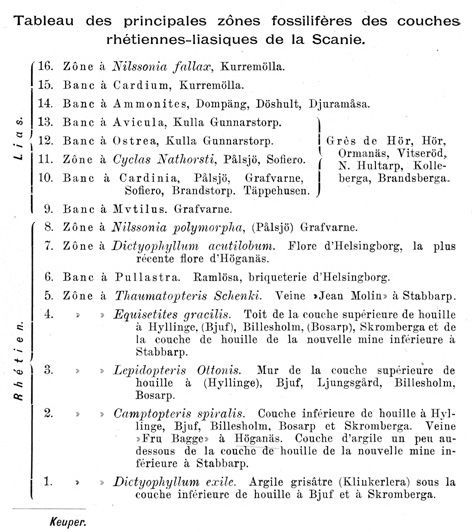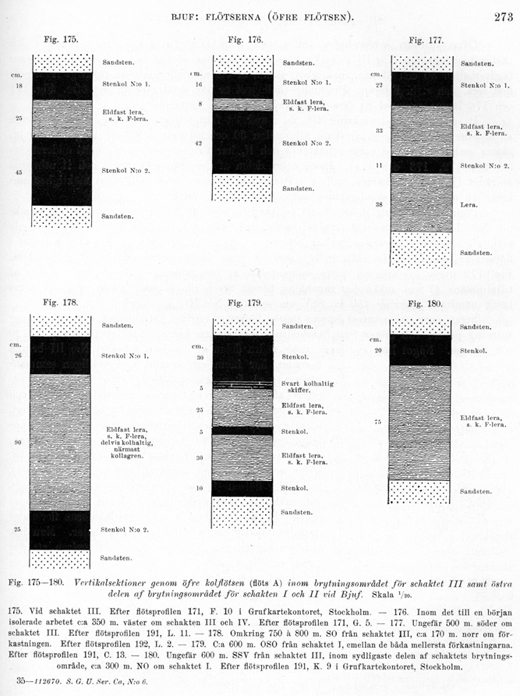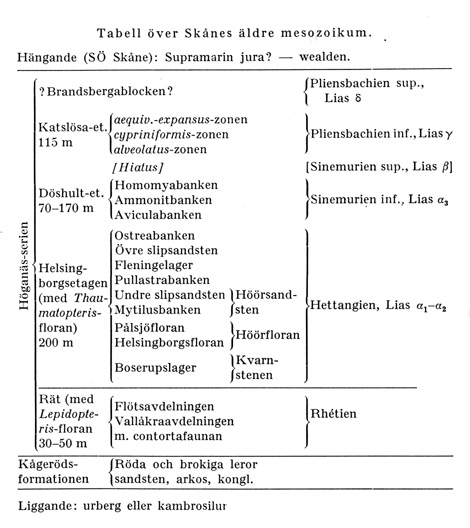History of the investigation of Age and Stratigraphy of the Plant Bearing Formation

Table 1. Principal fossil zones of the Rahetian-Liassic strata of Scania (Nathorst, 1910).

Table 2. Selection of stratigraphic profiles of the Scanian Coal Formation from a shaft at the Bjuv mine (Erdmann, 1911-1915).
In the middle of the 20th century, Anna Birgitta Lundblad wrote that professor Thore G. Halle “repeatedly pointed out" the need of a complete revision of Rhaetian-Liassic floras of Scania (Lundblad, 1950). Previously, Tom M. Harris (1937) had asked for a “critical revision of the stratigraphy and the specific determinations in the flora". The stratigraphy and the many biostratigraphic zones established by Nathorst and others were, until Gustaf Troedssons investgations, not subject to any major investigations, even though Antevs (1919) and Johansson (1922) pointed out the weakness in Nathorst´s zones. The need for revision was partly redressed by Troedsson (1938, 1940, 1943, 1950, 1951). In a number of publications he gave comprehensive, partly new, conclusions on the stratigraphy of the Rhaetian-Liassic succession of Scania, including chronostratigraphy, delimitation of some lithostratigraphical units (e.g., the Vallåkra Member, the strata of Boserup). Furthermore, he described the cyclic depositional environment linked to transgressions and regressions. In his publication of 1950 he presented a summary of the older Mesozoic strata of Scania (Table 3).

Table 3. Older Mesozoic of Scania (Troedsson, 1950).
The main features of Troedsson´s scheme (Troedsson 1950) are still a valid framework for the Rhaetian-Liassic stratigraphy of Scania. Improved techniques and continued investigations have shed new light on the question of the age of the plant bearing strata and the question of the Triassic-Jurassic boundary. However, it is very difficult to mark the Rhaetian-Liassic boundary with the lithology only. Biostratigraphic data too, is needed, which is the case for many drilling cores (Sivhed, 1980). In more recent time it has mainly been palynological studies that provided new data (e. g., Norling, 1972, Lund, 1977, Guy-Ohlson, 1981, Guy-Ohlson and Norling, 1994). Ulf Sivhed summarized current opinions on the Rhaetian to Middle Jurassic in Scania, with references to the works of Nilsson, Angelin, Lundgren, Nathorst, Erdmann, Troedsson, and Lundblad (commented on above). Sivhed (1984) also referred to more recent works of Edmund Bölau, 1949, Hans Tralau, 1975, Jens Lund, 1977 and Dorothy Guy-Olsson, 1981. Beside the summary of Sivhed there are older summaries by Nathorst (1876), Lundgren (1878), Troedsson (1943, 1950) and Lundblad (1946). Most recent, a comprehensive overview was given by Norling et al. (1993) in the “Guide to the Upper Triassic and Jurassic geology of Sweden". A stratigraphic scheme is presented in Table 3 (Sivhed, 1984). Today, the Triassic-Jurassic boundary seems to be undisputed lying between the Bjuv Member and the Helsingborg Member.
Agardh, C. A., 1823. Närmare bestämmande af några Vextaftryck funne uti Höganäs Stenkolsgrufvor. Kongl. Vetenskapsakademiens Handlingar 1823: 106-112.
Angelin, N. P., 1859 (map), 1877 (text). Geologisk Öfversigts-karta öfver Skåne. Ph. Lindstedt. Lund.
Antevs, E., 1919. Die Liassische flora des Hörsandsteins. Kungliga Svenska Vetenskapsakademiens Handlingar 59(8): 1-71.
Bölau, E., 1949. Berggrundstudier i trakten av Höganäs. Geologiska Föreningens i Stockholm Förhandlingar 71(3): 383-412.
Dittmar, A. von, 1864. Die Contorta-Zone (Zone der Avicula contorta Portl.) : Ihre Verbreitung und ihre organischen Einschlüsse. H. Manz. Münich. P9. 217p.
Erdmann, E., 1872. Beskrifning öfver Skånes Stenkolsförande Formation. Sveriges Geologiska Undersökning C 3. 87pp.
Erdmann, E., 1887. Beskrifning öfver Skånes Stenkolsfält och gruvor. Häfte 1. Sveriges Geologiska Undersökning C 65. 124pp.
Erdmann, E., 1911-1915. De skånska stenkolsfälten och dess tillgodogörande. Geologisk och tekninsk beskrivning. Sveriges Geologiska Undersökning Ca 6. 548pp.
Guy-Ohlson, D., 1981. Rhaeto-Liassic palynostratigraphy of the Valhall bore No. 1, Scania. Geologiska Föreningens i Stockholms Förhandlingar 103(2): 233-248.
Guy-Ohlson, D and Norling, E., 1994. Jurassic sequences in Sweden. Geobios, M. S. 17: 275-286.
Harland, W B., Armstrong, R. L., Cox A. V., Craig, L. E., Smith, A. G. and Smith D. G., 1990. A geologic time scale 1989. Cambridge University Press. Cambridge.
Harris, T. M., 1937. The fossil Flora of Scoresby Sound East Greenland. Part 5. Stratigraphic relations of the plant beds. Meddelelser om Grønland 112 (2): 82-86.
Hébert, M., 1869. Recherches sur l´âge des Grés á combustibles d´Helsingborg et d´Höganäs. Annales des Sciences Géologiques 1(2). 37pp.
Hermelin, S. G., 1773. Anmärkningar om Boserups stenkols-grufva och de öfrige stenkols-försök uti Skåne. Kungliga Svenska Vetenskapsakademiens Handlingar 34.
Hisinger, W., 1808. Samling till en mineralogisk Geografi öfver Sverige. 254 and 264 cont. H. A. Nordström. Stockholm.
Johansson, N., 1922. Die rätische flora der Kohlengruben dei stabbarp und skromberga in schonen. Kungliga Svenska Vetenskapsakademiens Handlingar 63(5): 1-78.
Linné, C. von, 1751. Carl Linnaei Skånska resa, på höga öfwerhetens befallning förrättad år 1749. Med rön och anmärkningar uti oeconomien, naturalier, antiquiteter, seder, lefnads-sätt. Med
tillhörige figurer. Med kongl. Maj:ts allernådigste privilegio, uplagd på Lars Salvii kostnad 1751. Stockholm.
Lund, J., 1977. Rhaetic to Lower Liassic palynology of the onshore south-eastern North Sea Basin. Danmarks Geologiske Undersögelse. Raekke 2: 109. 128pp.
Lundblad, B., 1946. De sista 35 årens bidrag till kännedomen om Sveriges mesozoikum. Geologiska Föreningens i Stockholms Förhandlingar 68(2). 251-267.
Lundblad, B., 1950. Studies in the Rhaeto-Liassic floras of Sweden 1. Kungliga Svenska Vetenskapsakademiens Handlingar 1(8): 2-82.
Lundblad, B., 1959. Studies in the Rhaeto-Liassic floras of Sweden 2:1. Kungliga Svenska Vetenskapsakademiens Handlingar 6(2): 1-38.
Lundgren, B., 1878. Studier över faunan i den stenkolsförande formationen i nordvästra Skåne. Kongl. Fysiografiska Sällskapets Minnesskift 1878: 1-58.
Nathorst, A. G., 1876. Bidrag till Sveriges fossila flora. Växter från rhätiska formationen vid Pålsjö i Skåne. Kungliga Svenska Vetenskapsakademiens Handlingar 14(3). 82pp.
Nathorst, A. G., 1878a. Beiträge zur fossilen Flora Schwedens. Über einige rhätiche Pflanzen von Pålsjö in Shonen. E Schweizerbart´sche Verlagshandung (E. Koch). Stuttgart. 34pp.
Nathorst, A. G., 1878b. Om floran i Skånes kolförande bildningar 1. Floran vid Bjuf, första häftet. Sveriges Geologiska Undersökning C 27: 1-52.
Nathorst, A. G., 1910. Les dépôts mésozoïques précrétacés de la Scanie. 11th International Geological Congress in Sweden: Excursion C6. 46pp.
Nilsson, S., 1819. Beskrifning öfver en petrikatförande sandsten vid Hör i Skåne. Kungliga Svenska Vetenskapsakademiens Handlingar 1819.
Nilsson, S., 1820a. Om försteningar och aftryck af tropiska trädslag och deras blad, funne i ett sandstenslager i Skåne. Kongl. Svenska Vetenskapsakademiens Handlingar St. II. a: 108-122.
Nilsson, S., 1820b. Om försteningar och aftryck af tropiska trädslag, blad, ormbunkar och rörväxter m. m. samt trädkol funna i ett sandstenslager i Skåne., Kongl. Svenska Vetenskapsakademiens Handlingar St. II. b: 277-285.
Nilsson, S., 1823. Underrättelse om några petrificater, fundna i den Skånska Stenkols-formationen. Kongl. Svenska Vetenskapsakademiens Handlingar 1823: 95-106.
Norling, E., 1972. Jurassic stratigraphy and foraminifera of western Scania, southern Sweden. Sveriges Geologiska Undersökning Ca 47. 120pp.
Norling, E., Ahlberg, A., Erlström, M. and Sivhed, U., 1993. Guide to the Upper Triassic and Jurassic geology of Sweden. Research paper. Sveriges Geologiska Undersökning Ca 82. 71pp.
Sivhed, U., 1980. Lower Jurassic Ostracodes and Stratigraphy of western Skåne, southern Sweden. Sveriges Geologiska Undersökning Ca 50. 61pp.
Sivhed, U., 1984. Litho- and biostratigraphy of the Upper Triassic-Middle Jurassic in Scania, southern Sweden. Sveriges Geologiska Undersökning C 806: 1-31.
Swedenborg, E., 1722. Miscellanea observata circa res naturales & praesertim circa mineralia, ignem & montium strata. Leipzig. 174pp.
Tralau, H., 1975. An Upper Triassic microflora from Vallåkra, southern Sweden. Geologiska Föreningens i Stockholm Förhandlingar 97(3): 237-242.
Troedsson, G., 1938. On the Sequence of strata in the rhaetic-Liassic beds of Scania. Geologiska föreningens i Stockholm förhandlingar 60(3): 547-550.
Troedsson, G., 1940. Om Höörs sandsten. Geologiska Föreningens i Stockholm Förhandlingar 62(3): 245-283.
Troedsson, G., 1943. Om gränsen mellan rät och lias i Skåne. Geologiska Föreningens i Stockholm Förhandlingar 65(3): 271-284.
Troedsson, G., 1950. Om lagerföljden inom Sveriges äldre mesozoikum. Meddelelser fra Dansk Geologisk Forening 11(5): 595-597.
Troedsson, G., 1951. On the Höganäs Series of Sweden (Rhaeto-Lias). Skrifter från Mineralogisk- och Paleontologisk-Geologiska Institutionerna, Lund: 7. 269pp.
Text: Ove Johansson


